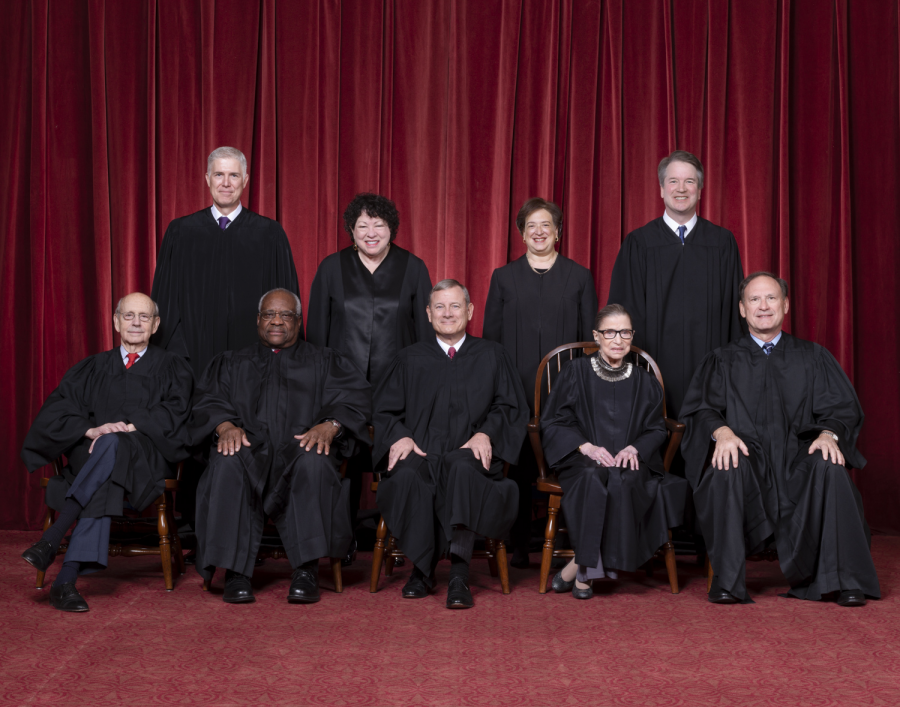The Judicial Branch: The Most Valuable Branch of the Federal Government
https://www.supremecourt.gov/about/justices.aspx
The current Supreme Court justices are Clarence Thomas, Ruth Bader Ginsberg, Stephen Breyer, Samuel Alito, Sonia Sotomayor, Elena Kagan, Niel Gorsuch, Brett Kavanaugh, and Chief Justice John Roberts.
December 17, 2019
When you were in elementary school, I guarantee many, if not all, of your teachers had a picture of the president of the United States of America underneath the American flag. Throughout your childhood whenever you talked about the government, the president’s name likely came up. In your mind, the president was probably associated as our sole leader. As you grew older, you learned there are actually three branches of government: the executive, the legislative, and the judicial. The president enforces the law in the executive, Congress creates law in the legislative, and the Supreme Court interprets the law in the judicial. Despite you learning about these other branches, and possibly even the checks they have on one another, in your mind it still registered that the president is the most important figure in our country. When in fact, the judicial branch is actually the most valuable section of our government.
Yes, the judicial branch is “the courts” but more specifically, it is the Supreme Court. The Supreme Court holds nine justices. These justices must be appointed by the president and approved by the Senate before they take office. There are no formal characteristics to be appointed to the Supreme Court, unlike the other branches. There is one position as Chief Justice, who obtains additional responsibilities to those of the associate justices. Unlike any other position, Supreme Court justice is a lifelong appointment. The current Supreme Court Justices are Clarence Thomas, Ruth Bader Ginsberg, Stephen Breyer, Samuel Alito, Sonia Sotomayor, Elena Kagan, Niel Gorsuch, Brett Kavanaugh, and Chief Justice John Roberts.
Although many Americans would likely struggle to name even a few of these justices, the power the justices hold is immeasurable. The judicial branch’s job is to interpret the Constitution. Citizens’ cases are brought to the Supreme Court where the court must decipher between what is permitted under the Constitution and what is not. It may sound simple, but applying modern standards to historic writing is a difficult task. With a living, breathing document such as the Constitution, however, we can accomplish it.
With this responsibility of interpretation comes another layer: precedent. Precedent is where a decision is made and a standard is set. That ruling then impacts future cases that are of similar nature. Not only does precedent alter the way the written law is construed, but it also impacts the societal views of the issue. Precedent is never lightly overturned, particularly the longer the precedent stands, the more difficult it becomes to disregard.
The main justifications to overturn a precedent are de facto and de jure. De facto is the set of social standard rules that the majority of the population coincide with. Although not officially enforced, these rules are accepted by society and rarely change overnight. De jure is the specific states laws of the government. These are the rules that are written and enforced by law.
In a 2013 transcript published by PRI, Paul Freund, former Harvard Law professor says, “The Court should never be influenced by the weather of the day but inevitably, they will be influenced by the climate of the era.”
The Court will take into consideration how America’s values evolve over time as opposed to opinions made that day. The Courts base their decisions on the people, which is a trait that is not always true of the other branches of government.
Not only does the Supreme Court have the authority to set precedents and rule on cases, but they also have the most powerful check of any of the three branches. The judicial branch has the power to deem an action completed by either the legislative branch or the executive branch unconstitutional. This would stop the action altogether without any further investigation into the matter. An example of this power would be deeming a new Congressional law unconstitutional, or classifying an action done by the president as unconstitutional. With just one declaration, the judicial branch can halt major actions.
The influence the Supreme Court has over the way we live is infinite. Whether or not the Court deems laws constitutional or not is not the main purpose, but rather the repercussions that will be in effect for a lifetime. Rulings such as Roe vs. Wade, Citizens United vs. FEC, Obergefell vs. Hodges, and Brown vs. Board of Education were all controversial topics that lastling decisions were based on. When these cases arrived to the Court, not only was the newly clarified law established, but thoughts from people across the country arose.
Without the Supreme Court, the country would have the propensity of tyranny. Everyone would see the laws in different ways, causing chaos among people in deciphering the correct way. Fortunately, the Court is here to assist with that. The judicial branch also keeps the legislative and executive branches in line by checking that their powers do not surpass the laws of our country.
If the Supreme Court didn’t exist, the law wouldn’t adapt to present day the way it does now. Laws wouldn’t be as vivid. Social standards would not change as easily. Modern rules would only be morally abided by instead of enforced by law. Controversy would spread dividing people on important issues. The Court is the foundation of our beliefs. The judicial branch is the one that leaves the influential marks on our country.
Sources Used:
https://www.supremecourt.gov/about/justices.aspx
https://www.pri.org/stories/2013-09-16/transcript-interview-supreme-court-justice-ruth-bader-ginsburg








